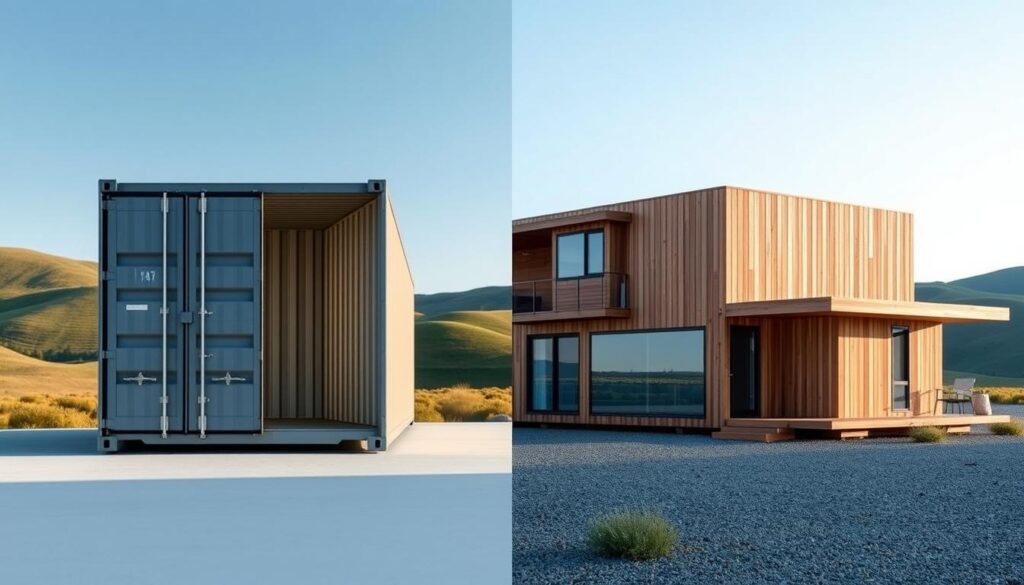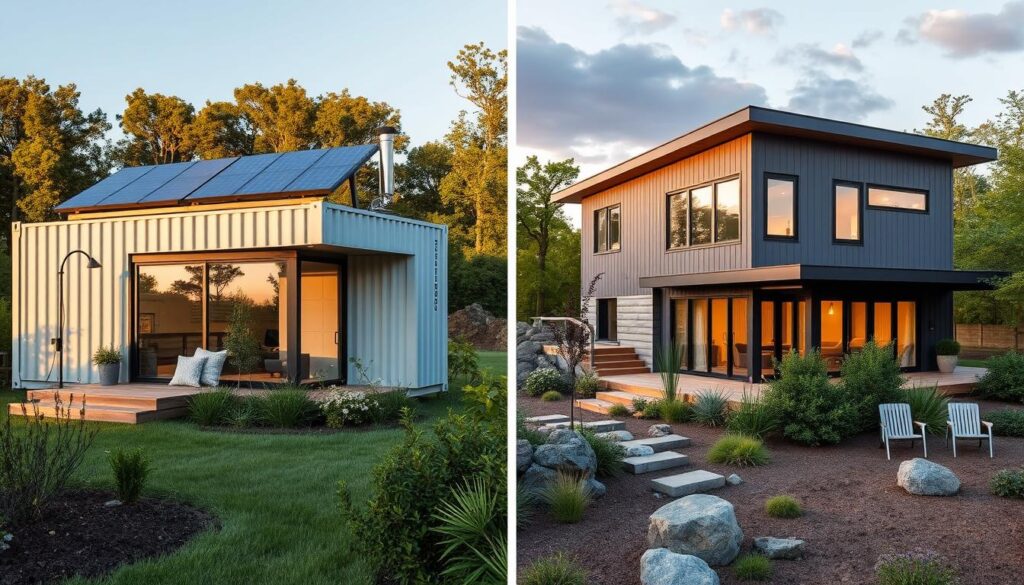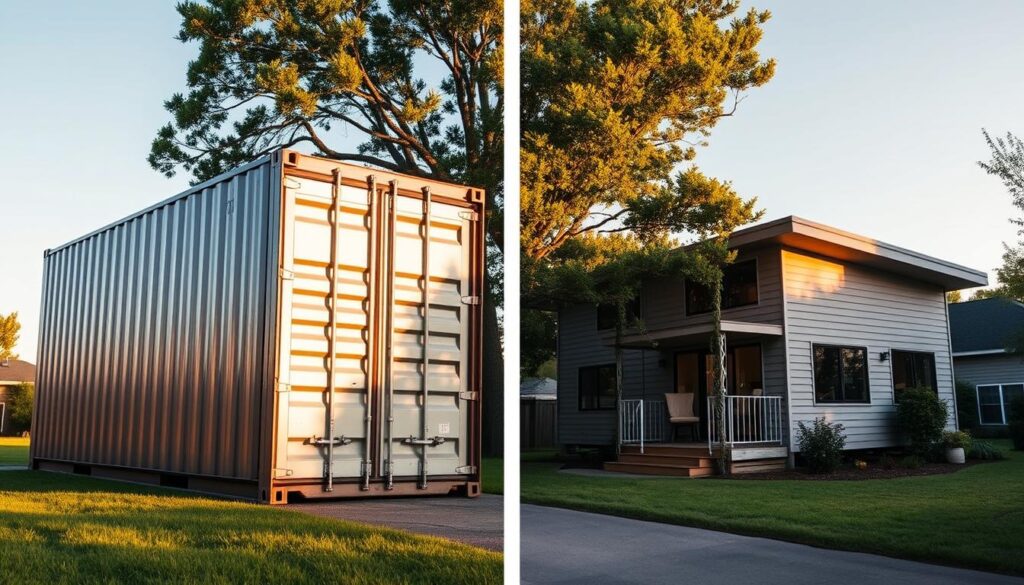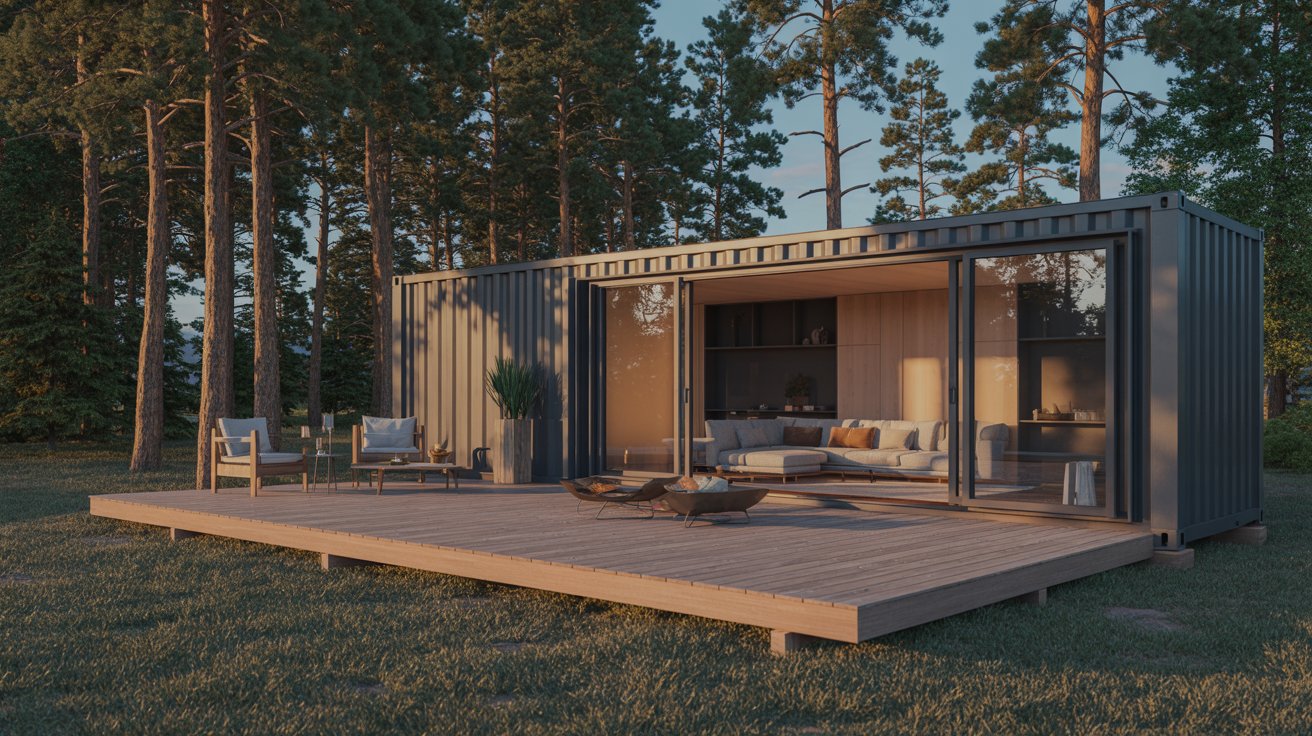Are you considering an alternative housing option but unsure whether to opt for a shipping container or a modular home? Both options have gained popularity in recent years due to their unique benefits and potential for sustainability.

The decision between these two innovative housing solutions depends on several factors, including your budget, personal preferences, and specific needs. While both options offer a faster construction timeline compared to traditional housing, they differ significantly in terms of design flexibility, energy efficiency, and overall cost.
Key Takeaways
- Understand the fundamental differences between shipping container and modular homes.
- Learn about the advantages and disadvantages of each housing option.
- Discover the factors to consider when choosing between the two.
- Explore the cost implications of shipping container vs modular homes.
- Find out which option is more suitable for your specific needs and budget.
The Rise of Alternative Housing Solutions
In recent years, the housing landscape has witnessed a significant shift towards alternative housing options. This change is driven by the need for more affordable, sustainable, and flexible living solutions. Two of the most promising alternatives are shipping container homes and modular homes.
What Are Shipping Container Homes?
Shipping container homes are dwellings made from repurposed shipping containers. These containers, originally designed for transporting goods across the globe, are now being adapted for housing.
Origins and Adaptation for Housing
The concept of using shipping containers as homes began as a response to the need for affordable and sustainable housing. By repurposing used containers, individuals can create unique and eco-friendly dwellings.
Basic Structural Characteristics
Shipping container homes are known for their durability and modular design. They can be stacked and combined to create larger living spaces. Key characteristics include their steel construction, rectangular shape, and potential for off-grid living.
What Are Modular Homes?
Modular homes, on the other hand, are prefabricated houses built in a factory and then transported to the building site. They are constructed in modules, which are then assembled on-site.
Factory-Built Housing Explained
Modular construction involves building homes in a controlled factory environment. This method allows for precision engineering and reduced waste, making it an attractive option for those seeking efficient and sustainable housing.
Modern Modular Construction Methods
Modern modular homes are built using advanced construction techniques and materials. They can be customized to meet individual needs and preferences, offering a range of design possibilities.
Why These Options Are Gaining Popularity
Both shipping container and modular homes are gaining popularity due to their sustainability, affordability, and flexibility. They offer prospective homeowners the opportunity to own a home that is not only eco-friendly but also tailored to their specific needs.
| Feature | Shipping Container Homes | Modular Homes |
|---|---|---|
| Construction Method | Repurposed shipping containers | Prefabricated modules built in a factory |
| Customization | Limited by container size and structure | Highly customizable |
| Sustainability | Eco-friendly through reuse of containers | Efficient construction process reduces waste |
Shipping Container vs Modular Homes: Key Differences
Shipping container homes and modular homes, though both innovative housing solutions, have distinct characteristics that may make one more suitable for you than the other.
The differences between these two options are multifaceted, ranging from their construction methods to their durability and size limitations. Understanding these differences is crucial in making an informed decision.
Construction Methods and Materials
Shipping container homes are made from repurposed shipping containers, typically constructed from corten steel, which provides inherent strength and durability. The construction process involves modifying these containers to create living spaces.
In contrast, modular homes are built using traditional construction materials such as wood or steel framing, insulation, and exterior finishes like vinyl or brick. The modules are constructed in a factory and then assembled on-site.
Structural Integrity and Durability
Shipping containers are designed to withstand harsh marine environments, making them incredibly durable. However, modifications for habitation can sometimes compromise their structural integrity if not done correctly.
Modular homes, being constructed in a controlled factory environment, are built to local building codes and can offer superior structural integrity. Their durability is often comparable to, if not better than, traditional site-built homes.
Size and Space Limitations
Shipping container homes are limited by the size of the containers used. While it’s possible to combine multiple containers, the initial space is constrained by the container’s dimensions.
Modular homes, on the other hand, can be designed to be much larger and more spacious, as they are not limited to the size of a shipping container. Modules can be added or removed as needed, offering greater flexibility.
Typical Lifespan Comparison
The lifespan of a shipping container home can vary significantly based on the quality of the modifications and maintenance. With proper care, they can last for decades.
Modular homes, being constructed with materials and techniques similar to traditional homes, can also last for many years, often matching or even exceeding the lifespan of site-built homes.
In conclusion, the key differences between shipping container and modular homes lie in their construction, durability, size flexibility, and potential lifespan. Understanding these factors is essential in choosing the right home for your needs.
Cost Comparison: Budget Considerations
The cost comparison between shipping container homes and modular homes is a critical factor in making an informed decision. Understanding the financial implications of each option is essential for prospective homeowners.
Initial Purchase and Construction Costs
The initial costs associated with both types of homes vary significantly. For shipping container homes, the primary expenses include container acquisition and modification.
Container Acquisition and Modification Expenses
Acquiring shipping containers can be relatively cost-effective, with prices ranging from $1,500 to $5,000 per container, depending on size and condition. Modification costs, however, can add $10,000 to $30,000 or more, depending on the extent of the renovations.
Modular Home Factory and Assembly Costs
Modular homes, on the other hand, are typically more expensive upfront. Factory costs can range from $30 to $100 per square foot, and assembly costs on-site can add another $5,000 to $15,000.
Long-term Maintenance Expenses
Maintenance costs are another crucial aspect to consider. Shipping container homes may require more frequent maintenance due to their metal construction, potentially leading to higher long-term costs.
Maintenance Cost Comparison
| Home Type | Average Annual Maintenance Cost | First 5 Years Total |
|---|---|---|
| Shipping Container Home | $1,000 – $3,000 | $5,000 – $15,000 |
| Modular Home | $500 – $2,000 | $2,500 – $10,000 |
Return on Investment and Resale Value
The resale value of both types of homes can be significant, but modular homes tend to appreciate more in value over time, similar to traditional housing.
In conclusion, while both shipping container and modular homes have their cost advantages and disadvantages, understanding these factors is key to making a financially informed decision.
Design Flexibility and Aesthetic Options
Design flexibility and aesthetic options play a pivotal role in the decision-making process for prospective homeowners considering shipping container or modular homes. The ability to customize and tailor one’s living space to individual tastes and needs is a significant advantage of both housing types.
Architectural Possibilities with Shipping Containers
Shipping containers offer a unique canvas for creative expression. Their modular nature allows for innovative stacking and arrangement options, enabling homeowners to achieve a variety of layouts and configurations.
Creative Stacking and Arrangement Options
The rectangular shape of shipping containers lends itself to easy stacking, allowing for multi-story homes with relative ease. This feature opens up a world of possibilities for creative spatial arrangements, from simple single-container homes to complex multi-container complexes.
Interior Design Challenges and Solutions
While shipping container homes offer many design possibilities, they also present unique interior design challenges, such as maintaining insulation and creating a comfortable living environment. Solutions include using appropriate insulation materials and designing interiors that maximize natural light and ventilation.

Design Options for Modular Homes
Modular homes, on the other hand, provide a different set of design advantages. They come in a variety of styles and can be customized to suit individual preferences, from modern to traditional aesthetics.
Available Styles and Customization
One of the key benefits of modular homes is their flexibility in design. Homeowners can choose from various floor plans and exterior finishes, allowing for a high degree of customization to suit their needs and tastes.
Expansion and Addition Possibilities
Modular homes also offer the advantage of being easily expandable. As needs change, additional modules can be added, making modular homes a versatile long-term housing solution.
Construction Timeline and Process
The construction timeline and process are key factors to consider when choosing between shipping container homes and modular homes. Understanding these elements can help you prepare for what to expect during the building process and ensure a smoother transition to your new home.
How Shipping Container Homes Are Built
Shipping container homes are constructed using repurposed shipping containers. The process involves several key steps:
- Site Preparation: The building site must be prepared, which includes clearing the land, laying the foundation, and connecting utilities.
- Modification and Assembly: Containers are then modified according to the design requirements, which may include cutting out sections for windows and doors, adding insulation, and assembling the containers into the desired configuration.
Site Preparation Requirements
Site preparation for shipping container homes requires careful planning. This includes ensuring the land is level and compact, preparing the foundation (which can be as simple as concrete piers or as complex as a full basement), and arranging for utility connections.
Modification and Assembly Process
The modification process involves altering the containers to fit the homeowner’s needs. This can include adding doors, windows, and interior finishes. The containers are then assembled on-site, requiring heavy machinery for placement.
The Modular Home Construction Process
Modular homes are built in a factory and then assembled on-site. The process includes:
- Factory Production Phase: Modules are constructed in a controlled factory environment, including the installation of electrical, plumbing, and HVAC systems.
- On-Site Assembly and Finishing: The modules are transported to the site, assembled, and finished with final touches such as roofing, siding, and interior decorating.
Factory Production Phase
In the factory, modular homes are built in sections or modules. This phase allows for simultaneous site preparation, reducing overall construction time. The modules are constructed with precision, including the installation of fixtures and finishes.
On-Site Assembly and Finishing
Once the modules are delivered to the site, they are assembled on the foundation. Final connections for utilities are made, and the home is completed with exterior finishes.
Comparing Construction Timeframes
Shipping container homes can be constructed relatively quickly, often within a few weeks to a few months, depending on the complexity of the design and the size of the home. Modular homes typically take a few months from start to finish, with the factory production phase and on-site assembly happening concurrently.
In conclusion, both shipping container and modular homes offer efficient construction processes, but the timelines can vary based on several factors, including design complexity and site conditions. Understanding these processes can help you make an informed decision that suits your needs and timeline.
Sustainability and Environmental Impact
Sustainability is no longer just a buzzword; it’s a critical consideration in the choice between shipping container and modular homes. As the world shifts towards more environmentally friendly practices, understanding the ecological footprint of our housing choices becomes increasingly important.
Eco-Friendly Aspects of Container Homes
Shipping container homes are often touted for their eco-friendly appeal, primarily due to the reuse and upcycling of materials that would otherwise end up in landfills.
Upcycling and Material Reuse
The process of transforming used shipping containers into living spaces reduces waste and conserves resources. This upcycling not only gives old containers a new life but also decreases the demand for new building materials.
Carbon Footprint Considerations
While the initial carbon footprint of shipping containers (from their original manufacturing and transportation) is significant, their reuse can mitigate this impact over time. However, it’s essential to consider the additional materials needed for conversion, such as insulation and roofing.

Environmental Benefits of Modular Construction
Modular homes, constructed in factories and assembled on-site, offer their own set of environmental benefits.
Reduced Construction Waste
Modular construction is known for minimizing waste through precise material estimation and the use of prefabricated components. This controlled environment reduces the likelihood of excess materials ending up in landfills.
Energy-Efficient Manufacturing
Many modular home manufacturers are adopting energy-efficient manufacturing processes, further reducing the environmental impact of production. This includes the use of renewable energy sources and sustainable materials.
Long-Term Sustainability Comparison
When comparing the long-term sustainability of shipping container homes and modular homes, several factors come into play. Both options have the potential to be sustainable, but their overall environmental impact depends on factors like materials used, energy efficiency, and maintenance over their lifespan.
- Shipping container homes excel in material reuse but may require additional insulation and finishing materials.
- Modular homes benefit from efficient factory production but may have a higher initial carbon footprint due to transportation.
In conclusion, both shipping container and modular homes offer unique sustainability advantages. The choice between them should be based on a comprehensive assessment of their environmental impact, from construction through to long-term occupancy.
Building Codes, Permits, and Regulations
Understanding the regulatory landscape is crucial when deciding between shipping container and modular homes. Both options are subject to various building codes, permits, and zoning regulations that can significantly impact the construction process and overall cost.
Navigating Regulations for Container Homes
Shipping container homes often face unique regulatory challenges due to their unconventional nature. Common regulatory hurdles include ensuring compliance with local building codes, obtaining necessary permits, and addressing zoning restrictions.
Common Regulatory Challenges
Container homes may be viewed with skepticism by local authorities, leading to additional scrutiny. Homeowners may need to provide extra documentation or modifications to meet local standards.
State and Local Variations
Regulations for container homes vary significantly across different states and local jurisdictions. It’s essential to research and understand the specific requirements in your area.
Modular Home Compliance with Building Codes
Modular homes, while still subject to local regulations, often have an easier time complying with building codes due to their factory-built nature. Factory certification processes play a crucial role in ensuring modular homes meet or exceed local building standards.
Factory Certification Processes
Modular home manufacturers typically have their factories certified by relevant state or national bodies, streamlining the compliance process.
Local Inspection Requirements
While modular homes benefit from factory certifications, they still require local inspections to ensure site-specific requirements are met.
Zoning Considerations for Both Options
Zoning laws can be a significant barrier for both shipping container and modular homes. Zoning regulations dictate not only the type of structure allowed in an area but also its placement and size.
Before investing in either option, it’s crucial to verify that your chosen location is zoned appropriately for your preferred type of home.
Livability and Comfort Factors
When considering alternative housing, livability and comfort are crucial factors to evaluate. Both shipping container and modular homes offer unique living experiences, but their designs impact daily life in different ways.
Space Utilization and Floor Plans
Space utilization is a significant aspect of livability. Shipping container homes, due to their rectangular shape, can sometimes result in awkwardly shaped floor plans if not designed carefully. In contrast, modular homes can be customized with more flexibility to suit individual needs, offering a potentially more comfortable living space.
Insulation and Climate Control Challenges
Insulation is critical for maintaining a comfortable living environment. Shipping containers, made of metal, can be prone to extreme temperatures without proper insulation.
Dealing with Metal Conductivity in Containers
To combat metal conductivity, shipping container homes require high-quality insulation materials and sometimes additional climate control measures. This can increase initial costs but is essential for livability.
Thermal Efficiency in Modular Homes
Modular homes, built with conventional materials, generally offer better thermal efficiency. Their construction allows for easier integration of insulation, making them potentially more comfortable in various climates.
Sound Proofing and Privacy Considerations
Sound proofing is another important factor. Modular homes, being constructed with standard building materials, typically offer better sound insulation compared to shipping container homes. However, with proper insulation and design, both types can achieve satisfactory sound proofing levels.
Health and Safety Aspects
Health and safety are paramount. Both shipping container and modular homes can be designed with safety in mind, but modular homes might have an edge due to their conventional construction methods, which often adhere more closely to traditional building codes and safety standards.
In conclusion, while both options have their pros and cons regarding livability and comfort, a thorough comparison can help prospective homeowners make an informed decision based on their priorities.
Who Should Choose Each Option?
Choosing between shipping container and modular homes depends on several factors that cater to your specific needs and preferences. Understanding these factors is key to making an informed decision.
Ideal Candidates for Shipping Container Homes
Shipping container homes are ideal for individuals or families who are looking for a cost-effective and eco-friendly housing solution. They are particularly suited for those who value uniqueness and are open to unconventional living spaces.
Budget Considerations
For those on a tighter budget, shipping container homes can be more affordable in terms of initial construction costs. However, it’s essential to consider the long-term costs, including insulation and potential modifications.
Lifestyle and Aesthetic Preferences
If you prefer a modern, industrial look or are drawn to the idea of repurposing existing materials, a shipping container home might be the perfect fit. They also appeal to those who enjoy DIY projects and are willing to invest time in customizing their home.
Best Scenarios for Modular Home Selection
Modular homes are best suited for individuals or families seeking a more traditional housing experience with the benefits of modern construction techniques. They are ideal for those who prioritize quality, durability, and a wide range of design options.
Family Size and Space Requirements
For larger families or those needing more space, modular homes offer greater flexibility in terms of size and layout. They can be easily expanded or configured to meet specific needs.
Long-Term Housing Needs
If you’re looking for a long-term housing solution that offers durability and low maintenance, modular homes are a great choice. They are built with high-quality materials and are designed to last.
Decision-Making Factors for Your Situation
When deciding between a shipping container home and a modular home, consider your budget, lifestyle, space requirements, and long-term needs. Weighing these factors will help you make the right choice for your situation.
| Considerations | Shipping Container Homes | Modular Homes |
|---|---|---|
| Initial Cost | Generally lower | Can be higher |
| Customization | High, with DIY potential | High, with various design options |
| Construction Time | Typically faster | Can be faster with modular construction |
| Long-Term Durability | Depends on modifications | High, with quality materials |
Conclusion: Making the Right Choice for Your Needs
Choosing between shipping container and modular homes depends on several factors, including budget, design preferences, and personal needs. Throughout this comparison, we’ve explored the key differences, advantages, and considerations for both options.
When deciding, consider the construction methods, cost implications, and environmental impact of each choice. Shipping container homes offer a unique, eco-friendly solution with a potentially lower upfront cost. Modular homes, on the other hand, provide design flexibility, structural integrity, and a more traditional living experience.
The decision-making process involves weighing these factors against your individual circumstances. By understanding the shipping container vs modular homes comparison, you can make an informed choice that suits your lifestyle and preferences.
Ultimately, whether you opt for a shipping container or a modular home, ensure that your decision aligns with your long-term goals and priorities. Careful consideration of these factors will lead to a satisfying and sustainable living solution.
Frequently Asked Questions
What are the main differences between shipping container and modular homes?
The primary differences lie in their construction methods, materials, and design flexibility. Shipping container homes are made from repurposed shipping containers, while modular homes are factory-built and assembled on-site.
Are shipping container homes more sustainable than modular homes?
Shipping container homes can be considered sustainable due to the reuse of existing materials. However, modular homes are also eco-friendly, with reduced construction waste and energy-efficient manufacturing processes. The sustainability comparison depends on various factors, including materials and construction methods.
How do the costs of shipping container homes compare to modular homes?
The costs of shipping container homes and modular homes vary depending on factors like size, materials, and location. Generally, shipping container homes can be more budget-friendly, but modular homes offer more customization options, which can impact the overall cost.
Can I customize the design of my shipping container or modular home?
Yes, both shipping container and modular homes offer design flexibility. Shipping containers can be creatively stacked and arranged, while modular homes come in various styles and can be customized to suit individual preferences.
What are the building regulations and permits required for shipping container and modular homes?
Building regulations and permits vary by location. Shipping container homes often face unique regulatory challenges, while modular homes are typically subject to standard building codes and inspections. It’s essential to research local regulations before choosing a housing option.
How do shipping container and modular homes compare in terms of energy efficiency?
Both housing types can be energy-efficient, but modular homes are often built with energy-efficient manufacturing processes and materials. Shipping container homes require additional insulation and climate control measures to achieve energy efficiency.
What are the typical construction timelines for shipping container and modular homes?
Shipping container homes can be built relatively quickly, with construction timelines varying depending on the complexity of the design. Modular homes are also constructed efficiently, with factory production and on-site assembly reducing overall construction time.
Can I expand or modify my shipping container or modular home in the future?
Yes, both housing types can be expanded or modified. Shipping containers can be stacked or rearranged, while modular homes can be designed with expansion possibilities in mind. However, it’s crucial to consider local building regulations and permits before making any changes.

